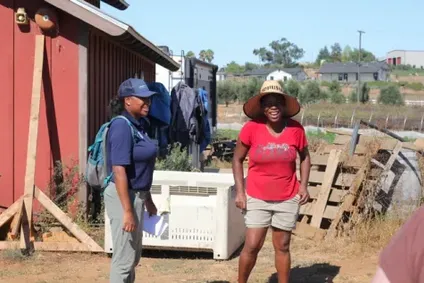
“Just don’t give up on what you’re trying to do. Where there is love and inspiration, I don’t think you can go wrong.” – Ella Fitzgerald
These are words that Chandra Richards, University of California Cooperative Extension land use academic coordinator for Southern California, lives by. A champion of sustainable agriculture, Richards focuses her work on supporting underserved farming communities through land access, equity and diversification.
Richards is the principal investigator for the Climate Action and Land Equity project, or CALE, administered through UC Agriculture and Natural Resources and funded by the California Department of Conservation. CALE aims to engage historically underrepresented communities in coalition building, capacity assessment and climate action planning. CALE elevates knowledge about the challenges and opportunities to land access and management for a diversity of land managers.
“I find myself in this field because I want to help farmers and ranchers safeguard their operations,” said Richards, who is based at the UCCE office in San Diego County. “I also recognize the importance of funding for implementation – to boost natural resources in the soil, to fund farmer needs and to protect agricultural lands in perpetuity.”
Richards, who holds a Ph.D. in soil biogeochemistry from UC Berkeley, describes her work as difficult but incredibly rewarding. It may not be all smooth sailing, but Richards has experience in drawing on the expertise of others to achieve a shared goal.
For her Ph.D. project, “Not only did I design and perform several year-long sampling campaigns from a small canoe, but I also processed over 1,000 water and soil samples in the laboratory,” Richards remembers. She was able to finalize this work through collaboration with colleagues on fish ecology and water dynamics, as well as with local stakeholders to safeguard steelhead trout and other aquatic species and ensure the long-term management of the Pescadero Estuary.
For those interested in reading Richards' dissertation, it is titled “Biogeochemical sulfur cycling in the bar-built Pescadero Estuary: Interdisciplinary investigations into near-annual fish mortality events” and can be found here: https://escholarship.org/uc/item/2kp7v24m.
“I promote land linkages and succession plans to protect agricultural lands and also to transfer terms to other land stewards, farmers and ranchers, and especially California Native American tribes, who are actively working towards ‘land back’ of their traditional and cultural spaces,” Richards explained. Land back is a movement focused on returning land to Indigenous people, and includes a variety of actions to improve their access to and stewardship of ancestral homelands.
However, with the massive costs to build and maintain an agricultural operation, Richards said what’s needed most right now is “unwavering and unprecedented support for historically underrepresented communities, land stewards, tribes and advocates, including small, new and minority farmers.”
Specifically, she sees the need for conservation and management resources, trainings, business and legal support, and financial assistance for California’s land stewards – in both current and future generations.
Despite some daunting challenges, Richards said the future of farming looks bright, “especially when it comes to sustainability and resilience” and innovative techniques and technologies that promote healthy food production.
“Urban and vertical farming methods benefit both environmental and community health, while improving food security and reducing urban temperatures,” Richards explained. “Hydroponics is an affordable and water-efficient method to grow plants and can lead to faster plant growth and higher yields than traditional methods.”
“Similarly, regenerative agricultural practices can increase the amount of carbon and moisture stored in soil while providing multiple benefits to the environment, crops and productivity,” Richards added. “Lastly, the rise of drones for monitoring, surveillance and resource application is an exciting new field that will support land stewards to improve efficiency, health, resilience and the overall state of their operations – while helping them adapt to climate changes.”
Equitable land-use issues will likely remain for the foreseeable future, due to their systemic and generational nature. But Richards hopes that her work with historically underserved and underrepresented communities will help more people feel supported and equitably funded.
“I recognize the importance of funding for implementation – to boost moisture and carbon in the soil, to fund farmer needs and to protect agricultural lands,” Richards said.
